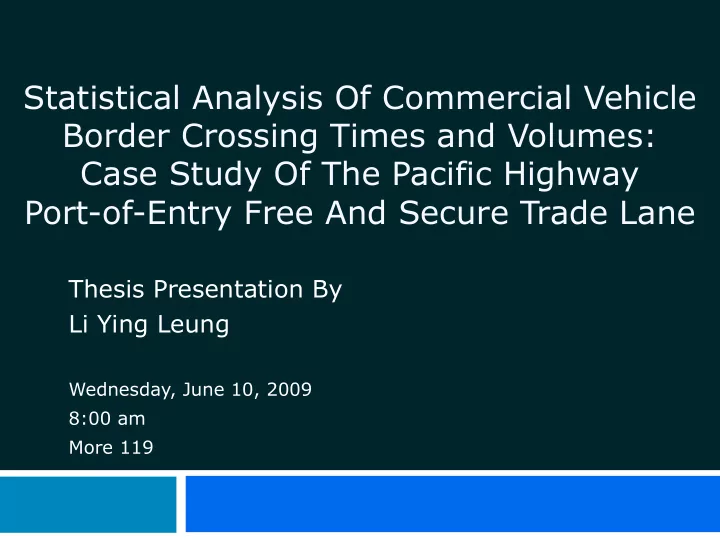

Statistical Analysis Of Commercial Vehicle Border Crossing Times and Volumes: Case Study Of The Pacific Highway Port-of-Entry Free And Secure Trade Lane Thesis Presentation By Li Ying Leung Wednesday, June 10, 2009 8:00 am More 119
Pacific Highway Port-of-Entry 2 FAST Lane
Findings (1 of 2) 3 1. Relationships between crossing times and arrival volume Strong correlation at aggregate level a) Not strong at a disaggregate level b) 2. Non-primary crossing times contribute to very long crossing times
Findings (2 of 2) 4 3. FAST lane utilized by vehicles who transport: Bulk a) Empty b) 4. Complex sampling can a) reduce resources b) same results with higher precision
Very Long Crossing Times Methods 5 Temporal Trends of arrival 1) volumes and crossing times Correlation between arrival 2) volumes and crossing times Primary and Non-Primary 3) Concepts Lane Utilization by Commodity 4) ¤ Complex Sample Survey Techniques
Crossing Time Data Set 6 ¨ Jet Star GPS Data Set ¨ Southbound ¨ July 10, 2005 through May 19, 2009 ¨ FAST Hours: 8AM-8PM Mondays through Fridays #Obs Mean Standard Median Min Max Deviation 13,680 00:17:03 00:19:18 00:11:44 00:00:14 04:42:51
Arrival Volume Data Set 7 ¨ BC MoT Data Set Source: Google Maps ¨ 5 minute average intervals ¨ 5 paired loop detectors ¨ November 13, 2006 through May 5, 2008 ¨ FAST Hours ¨ 388,500 observations Source: WCOG Border Data Warehouse
Trends between Arrival Volume and Crossing Times in 2007 8
Temporal Correlations (R) 9 Seasons R Average crossing time Spring 0.43 19 minutes, 25 seconds Summer 0.46 17 minutes, 38 seconds Fall 0.22 16 minutes, 30 seconds Winter 0.32 21 minutes, 38 seconds Weekdays R Average crossing time Monday 0.37 20 minutes, 35 seconds Tuesday 0.30 18 minutes, 25 seconds Wednesday 0.40 19 minutes, 38 seconds Thursday 0.44 15 minutes, 9 seconds Friday 0.46 22 minutes, 24 seconds
Primary and Non-Primary 10
Lane Choice Analysis 11 WCOG Manifest data High resolution for microscopic time period data June 5-8, 2006 1,200 observations
Hypothesis Testing 12 ¨ Test the differences between average lane choice by commodity ¨ Null Hypothesis: ¤ “Is there a difference between a commodity’s lane choice and the lane The image cannot be displayed. Your computer may not have enough memory to open the image, or the image may have been choice for all commodities” corrupted. Restart your computer, and then open the file again. If the red x still appears, you may have to delete the image and then insert it again. ¨ Alternative Hypothesis: ¤ There is no difference The image cannot be displayed. Your computer may not have enough memory to open the image, or the image may have been corrupted. Restart your computer, and then open the file again. If the red x still appears, you may have to delete the image and then insert it again. ¨ Significance level of 5%
Two-Sample T-Test Results 13 Commodity Type Significance Lane Choice Manufacturing ✔ Middle Unknown x Food ✔ Middle Wood x Bulk ✔ FAST Farm x Printed Matters x Empty Truck ✔ FAST Container/Pallet
Methodologies 14 Correlation between Crossing Temporal Trends Times and Arrival Volume Very Long Crossing Times Primary and Non-Primary Lane Choice Analysis Crossing Times
Complex Sampling Analysis 15 ¨ “A simple random sample is almost always better than a non-random sample. A more complex random sample is often even better than a simple random sample: lower cost for the same precision” (Lumley, 2009)
Parameter Estimation of 2007 16 Mean Estimates Sampling Type Mean Standard Error Empirical 00:18:58 00:20:19 Simple Random 00:19:00 00:21:47 Sampling Simulated 00:19:02 00:01:26 Standard Deviation Estimates Empirical Mean Simulated Mean Standard Error of of the Standard of the Standard the Standard Deviation Deviation Deviation 00:20:19 00:19:51 00:03:38
Complex Sampling 17 Year Bootstrap Simple Random Empirical Data Sample Mean Standard Mean Standard Mean Standard error error error 2007 00:17:37 00:00:48 00:19:16 00:20:42 00:18:58 00:20:19 2008 00:17:36 00:02:02 00:15:31 00:22:37 00:14:47 00:19:32
Recommendations 18 ¨ Sample survey ¤ Infer the same estimates with less costs ¤ High resolution for macroscopic time period data ¨ Applied to future studies ¤ Sumas ¤ Lynden ¤ Blaine Source: WCOG 2009
19 Thank you Contact Information: Li Leung lileung@u.washington.edu
Recommend
More recommend